The Project
In 2012 the proposal to refurbish the town pump was first put forward as a possible project for the Newark Civic Trust by Life Member John Oldham. It was suggested that this project could be completed in 2014 to mark the 50th anniversary of the formation of the Trust; an idea that was fully supported by the Committee and by Newark and Sherwood District Council (NSDC) who were at that time in ownership of the pump. Quotes were obtained for the work and we were quick to realise that any work to the pump would require additional external funding. Our only option therefore would be to apply for grants from local and/or national grant giving organisations. We knew that if we went down this route there would be a possibility that we wouldn’t be able to complete the work in time for the anniversary so the project was put on hold.
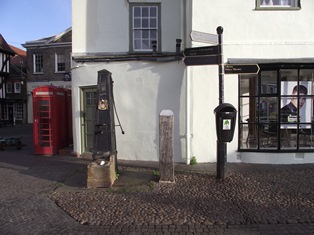
In 2014 our 50th anniversary was celebrated at the Newark Town Hall as we hosted Professor Martyn Bennett who delivered a lecture on Newark and its role in the Civil War. Once this event was over our discussions were once again held on how the Trust could refurbish the town pump. We met with NSDC and Malcolm Lane & Sons in November 2014 to discuss the project. The discussion included how the pub should best be refurbished and how it should be protected in the future.
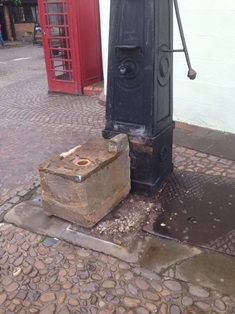
We decided that it would be a good idea to install several bollards in front of the pump, and the trough that sits in front of it, as the trough had been struck several times by vehicles using the market place. The bollards that we installed matched the existing bollards in the market place as closely as possible to maintain its uniform appearance. It was also decided that the trough would repairing as this had been heavily damaged in recent years. The decision was made to remove all of the concrete mortar, possibly added during the 1960s, and to clean the existing stone. Another object associated with the pump was the large metal plate located to its right. This plate was worn quite badly and we initially considered removing and disposing of it. But at first we were unsure how old the plate was or why it was even there. We first thought that it may have been a drain or well-cover but we realised the surface underneath was solid ground. It was then suggested that the plate was actually a standing plate for people using the pump as the two areas of wear matched the standing position of someone operating the pump with their right-hand. Due to the patterns of wear and the material used we ascertained that the plate may well have been at least a 100 years old. As part of the project it was agreed to lift and clean the plate of chewing gum and cleared of weeds before being securely rebedded.
All of the work was completed in May 2016. On day 1 the existing ironwork was cleaned down to provide a stable base for the new layers of paint. The housing behind the trough was removed and swapped for the rearmost section as three of the base plates contained a ‘laurel’ decoration; the front plate was hidden by the trough. The removal of the plates allowed us to look inside the housing. Unfortunately none of the original pump mechanism remained as this had been removed to make way for a lead water pipe which fed a tap which has since been replaced by the current spout. A base layer of paint was also applied to all of the existing metalwork.
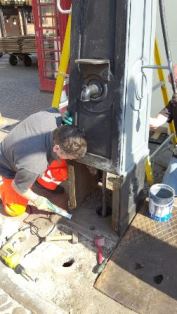
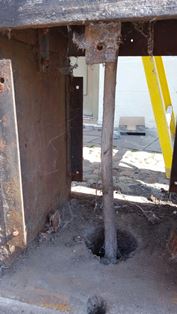
Day 2 involved applying a coat primer in the morning followed by the first coat of coach paint later in the day. Once the painting had been completed the bollards were installed.
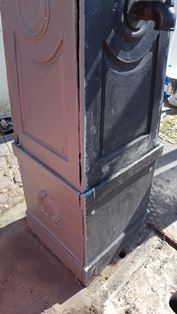
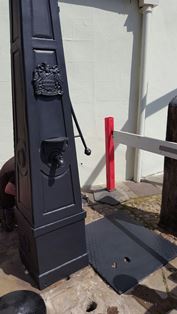
Days 3, 4 and 5 Involved the final layer of coach paint as well as the first layers of coloured paints on the coat of arms and gold detailing. Each layer of decorative paintwork needed 24 hours to dry before the second coat could be applied. The refurbished stone trough was also fixed back into position. On day 5 a clear acrylic varnish was added to help protect the coloured paintwork.
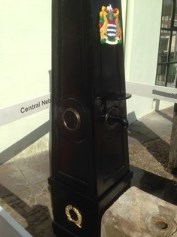
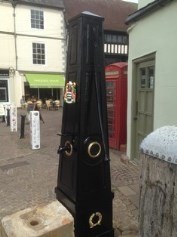

From left, Newark Town Council clerk Mr Alan Mellor, town and district councillor Mr David Lloyd, Mr Michael Knapton and Mr Ian Harrison, the district council’s business manager for car parking and markets (image courtesy of the Newark Advertiser)
The Arms
The Newark Civic Coat of Arms was awarded in 1561, one of the first towns in the country to receive the honour. The motto: ‘DEO FRETUS ERUMPE’ means ‘Trust in God and sally forth’. This was said by the Mayor to Lord Belasyse, the military Governor, when King Charles I ordered the town to surrender on 6 May 1646. The Mayor believed the town could fight on. The blue wavy lines, the beaver, the otter and the waterfowl, with an eel in its mouth, symbolise Newark’s location on the River Trent. In 1915 the bird on the crest was described as a cormorant.
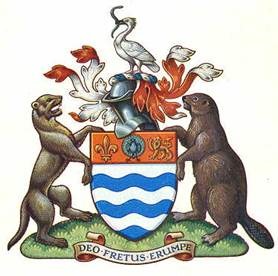
The original grant described the bird as a morfex, possibly a corruption of ‘morfran’, the Welsh name for a cormorant. The fleur-de-lis and lion are royal emblems, the peacock symbolises pride or immortality.
For a detailed account of the Coat of Arms click here.
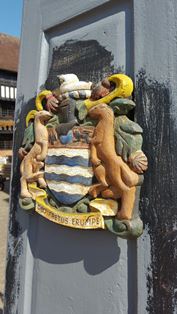
The Arms before refurbishment
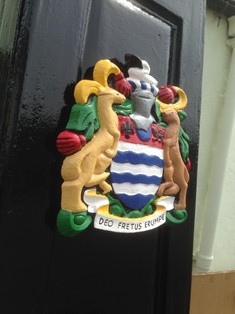
The arms after refurbishment
Town Pump
In 2015/16 the Newark Civic Trust embarked on a project to refurbish the Newark town pump while also installing an information board to allow passers-by to learn more about this small but important part of Newark’s heritage. The project was funded by the Heritage Lottery Fund. Feel free to contact us if you have any information or memories of the pump or any other pumps in or around Newark.


